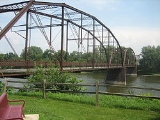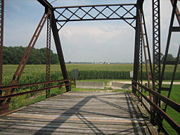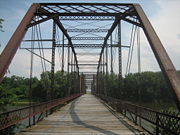
Lyndon Bridge
Encyclopedia
The Lyndon Bridge is a metal Parker Pratt through-truss bridge
in the village of Lyndon
, Whiteside County, Illinois, United States. The Lyndon Bridge was designed by engineer R.S. Riser and completed in 1894 for around $20,000. Whiteside County maintained the bridge from its construction until it was closed to all traffic in 1980. In 1995, as the county was about to demolish the bridge, a group of citizens worked together and saved it from demolition. The bridge was listed on the U.S. National Register of Historic Places
in 2003.
In 1876 the village of Lyndon first approached Whiteside County officials about the construction of a bridge over the Rock River
in the village. That petition was denied and the county was not approached about a Lyndon bridge again until 1891, when the county agreed the village needed a bridge. The county appointed a bridge committee and the project began. The bridge committee first met on June 30, 1891 on the site of Lyndon Bridge. At another meeting, on February 18, 1892, the committee decided to seek bids for the construction of the bridge. At the same meeting the committee selected R.S. Riser, an engineer, to plan and design the bridge for a cost of no more than $50; Riser was paid the full $50. The committee received eight bids at another meeting, held on March 10, 1892. The bids ranged from the lowest at $16,400 to the highest at $19,127. The bridge committee ultimately went with the lowest bid from Keefers & Wyncoop.
The committee continued to meet after the contract was awarded, deciding various aspects of construction details and employment on the project. For instance, during a July 1894 meeting the committee employed a man to watch the bridge's construction for $1.50 per day; they ended up paying him a total of slightly more than $56. The bridge was completed in late 1894 for a total cost of $19,606.25.
 When the bridge was first constructed it was designed to primarily support wagon
When the bridge was first constructed it was designed to primarily support wagon
traffic. As technology progressed, and automobile
s and tractor
s became more common, Whiteside County officials were prompted to make alterations to the bridge in 1906. During the work the original wood stringers were replaced with 7 inches (177.8 mm) steel
I-beam
s, a new wood deck was laid and steel lattice rails were added. The bridge continued to require maintenance and persistent flooding required the county to add another span to the bridge in 1912. The new span lifted the bridge out of and over the flood plain.
Throughout its history the Whiteside County Highway Department kept detailed records of their maintenance on Lyndon Bridge. The wooden deck of the bridge has been replaced four times - in 1906, 1920, 1968, and 1976.
In 1920 the bridge deck needed repair. The repairs were completed and the bridge repainted, marking the last time Lyndon Bridge was painted. In 1939 the south pier began to settle into the riverbed. The concrete
piling and some of the concrete inside the pier's steel casing was deteriorating. The dilapidated concrete in the casing was replaced and a new concrete footing was poured. In 1968 the abutment
on which the bridge's south approach rests was repaired and a new deck installed at a cost of $6,800. The deck was again replaced in 1976 for an additional $4,500.
 The bridge was inspected regularly but it eventually fell into disuse. Truck loads increased and roads and methods of transport became more efficient and of better quality causing the bridge's importance to wane. Though the bridge was still a short cut to the farms south of Lyndon as well as to Prophetstown
The bridge was inspected regularly but it eventually fell into disuse. Truck loads increased and roads and methods of transport became more efficient and of better quality causing the bridge's importance to wane. Though the bridge was still a short cut to the farms south of Lyndon as well as to Prophetstown
and Tampico
the county could not maintain such a limited use bridge. On June 30, 1980 the county inspection resulted in the bridge being closed to all vehicular and pedestrian
traffic. The bridge, which had a four-ton weight limit the eleven years preceding its closure, sat neglected for the next 15 years.
In 1995 the Whiteside County Highway Department decided to demolish Lyndon Bridge. A group of citizens in Lyndon then sought to save the bridge as part of Lyndon's history. The group led a successful "Save the Bridge" campaign and the Village of Lyndon received the title to the bridge in 1998. Whiteside County maps list the bridge as "abandoned".
 R.S. Riser's original design was a Parker Pratt bridge, as selected by the bridge committee. It consisted of three 200 foot (61 m) spans. Each span consisted of ten 20 foot (610 cm) long panels, where each panel met there were 15 inch (381 mm) I-beams between the truss
R.S. Riser's original design was a Parker Pratt bridge, as selected by the bridge committee. It consisted of three 200 foot (61 m) spans. Each span consisted of ten 20 foot (610 cm) long panels, where each panel met there were 15 inch (381 mm) I-beams between the truss
es which held the stringer
s supporting the deck panels.
. Of those, only six were Parker through truss bridges from the period of the Lyndon Bridge's construction and early use, 1898-1917. Of the bridges surveyed in 1994, the Lyndon Bridge was most similar to the Division Street Bridge in Lockport, Illinois
. The Division Street Bridge, no longer extant, crossed the Des Plaines River
with two 200 feet (61 m) pin-connected Pratt through truss spans. The Lyndon Bridge later had its National Register eligibility determined by the Illinois Historic Preservation Agency
despite being omitted from the 1994 survey. The bridge was added to the U.S. National Register of Historic Places on May 9, 2003.
Truss bridge
A truss bridge is a bridge composed of connected elements which may be stressed from tension, compression, or sometimes both in response to dynamic loads. Truss bridges are one of the oldest types of modern bridges...
in the village of Lyndon
Lyndon, Illinois
Lyndon is a village in Whiteside County, Illinois, United States. The population was 648 at the 2010 census, up from 566 at the 2000 census.-Geography:Lyndon is located at ....
, Whiteside County, Illinois, United States. The Lyndon Bridge was designed by engineer R.S. Riser and completed in 1894 for around $20,000. Whiteside County maintained the bridge from its construction until it was closed to all traffic in 1980. In 1995, as the county was about to demolish the bridge, a group of citizens worked together and saved it from demolition. The bridge was listed on the U.S. National Register of Historic Places
National Register of Historic Places
The National Register of Historic Places is the United States government's official list of districts, sites, buildings, structures, and objects deemed worthy of preservation...
in 2003.
History
The idea of a bridge in Lyndon was first proposed in 1876, but it was not approved until 1891.In 1876 the village of Lyndon first approached Whiteside County officials about the construction of a bridge over the Rock River
Rock River (Illinois)
The Rock River is a tributary of the Mississippi River, approximately long, in the U.S. states of Wisconsin and Illinois. It rises in southeast Wisconsin, in the Theresa Marsh near Theresa, Wisconsin in northeast Dodge County, Wisconsin approximately south of Fond du Lac, Wisconsin...
in the village. That petition was denied and the county was not approached about a Lyndon bridge again until 1891, when the county agreed the village needed a bridge. The county appointed a bridge committee and the project began. The bridge committee first met on June 30, 1891 on the site of Lyndon Bridge. At another meeting, on February 18, 1892, the committee decided to seek bids for the construction of the bridge. At the same meeting the committee selected R.S. Riser, an engineer, to plan and design the bridge for a cost of no more than $50; Riser was paid the full $50. The committee received eight bids at another meeting, held on March 10, 1892. The bids ranged from the lowest at $16,400 to the highest at $19,127. The bridge committee ultimately went with the lowest bid from Keefers & Wyncoop.
The committee continued to meet after the contract was awarded, deciding various aspects of construction details and employment on the project. For instance, during a July 1894 meeting the committee employed a man to watch the bridge's construction for $1.50 per day; they ended up paying him a total of slightly more than $56. The bridge was completed in late 1894 for a total cost of $19,606.25.

Wagon
A wagon is a heavy four-wheeled vehicle pulled by draught animals; it was formerly often called a wain, and if low and sideless may be called a dray, trolley or float....
traffic. As technology progressed, and automobile
Automobile
An automobile, autocar, motor car or car is a wheeled motor vehicle used for transporting passengers, which also carries its own engine or motor...
s and tractor
Tractor
A tractor is a vehicle specifically designed to deliver a high tractive effort at slow speeds, for the purposes of hauling a trailer or machinery used in agriculture or construction...
s became more common, Whiteside County officials were prompted to make alterations to the bridge in 1906. During the work the original wood stringers were replaced with 7 inches (177.8 mm) steel
Steel
Steel is an alloy that consists mostly of iron and has a carbon content between 0.2% and 2.1% by weight, depending on the grade. Carbon is the most common alloying material for iron, but various other alloying elements are used, such as manganese, chromium, vanadium, and tungsten...
I-beam
I-beam
-beams, also known as H-beams, W-beams , rolled steel joist , or double-T are beams with an - or H-shaped cross-section. The horizontal elements of the "" are flanges, while the vertical element is the web...
s, a new wood deck was laid and steel lattice rails were added. The bridge continued to require maintenance and persistent flooding required the county to add another span to the bridge in 1912. The new span lifted the bridge out of and over the flood plain.
Throughout its history the Whiteside County Highway Department kept detailed records of their maintenance on Lyndon Bridge. The wooden deck of the bridge has been replaced four times - in 1906, 1920, 1968, and 1976.
In 1920 the bridge deck needed repair. The repairs were completed and the bridge repainted, marking the last time Lyndon Bridge was painted. In 1939 the south pier began to settle into the riverbed. The concrete
Concrete
Concrete is a composite construction material, composed of cement and other cementitious materials such as fly ash and slag cement, aggregate , water and chemical admixtures.The word concrete comes from the Latin word...
piling and some of the concrete inside the pier's steel casing was deteriorating. The dilapidated concrete in the casing was replaced and a new concrete footing was poured. In 1968 the abutment
Abutment
An abutment is, generally, the point where two structures or objects meet. This word comes from the verb abut, which means adjoin or having common boundary. An abutment is an engineering term that describes a structure located at the ends of a bridge, where the bridge slab adjoins the approaching...
on which the bridge's south approach rests was repaired and a new deck installed at a cost of $6,800. The deck was again replaced in 1976 for an additional $4,500.

Prophetstown, Illinois
Prophetstown is a city in Whiteside County, Illinois, United States. The population was 2,080 at the 2010 census, up from 2,023 at the 2000 census.-Geography:Prophetstown is located at ....
and Tampico
Tampico, Illinois
Tampico is a village located in Tampico Township, Whiteside County, Illinois, United States. As of the 2010 census the village had a total population of 790, up from 772 at the 2000 census. U.S. President Ronald Reagan was born there and lived there for two brief periods of his...
the county could not maintain such a limited use bridge. On June 30, 1980 the county inspection resulted in the bridge being closed to all vehicular and pedestrian
Pedestrian
A pedestrian is a person traveling on foot, whether walking or running. In some communities, those traveling using roller skates or skateboards are also considered to be pedestrians. In modern times, the term mostly refers to someone walking on a road or footpath, but this was not the case...
traffic. The bridge, which had a four-ton weight limit the eleven years preceding its closure, sat neglected for the next 15 years.
In 1995 the Whiteside County Highway Department decided to demolish Lyndon Bridge. A group of citizens in Lyndon then sought to save the bridge as part of Lyndon's history. The group led a successful "Save the Bridge" campaign and the Village of Lyndon received the title to the bridge in 1998. Whiteside County maps list the bridge as "abandoned".
Design

Truss
In architecture and structural engineering, a truss is a structure comprising one or more triangular units constructed with straight members whose ends are connected at joints referred to as nodes. External forces and reactions to those forces are considered to act only at the nodes and result in...
es which held the stringer
Stringer
Stringer may refer to:* Stringer , a type of freelance journalism* Stringer * Stringer , or longeron, a strip of wood or metal to which the skin of an aircraft is fastened...
s supporting the deck panels.
Significance
The Lyndon Bridge was influential on Lyndon's history and development as it provided easier access to the town. The Lyndon Bridge is the last remaining metal through truss bridge in Whiteside County. The Illinois Historic Bridge Survey, which Lyndon Bridge was not a part of, identified 374 Illinois highway-related bridges that were eligible for listing on the U.S. National Register of Historic PlacesNational Register of Historic Places
The National Register of Historic Places is the United States government's official list of districts, sites, buildings, structures, and objects deemed worthy of preservation...
. Of those, only six were Parker through truss bridges from the period of the Lyndon Bridge's construction and early use, 1898-1917. Of the bridges surveyed in 1994, the Lyndon Bridge was most similar to the Division Street Bridge in Lockport, Illinois
Lockport, Illinois
Lockport is a city in Will County, Illinois, United States, that incorporated in 1853. Lockport is located in northeastern Illinois, 30 miles southwest of Chicago, and north of Joliet, at locks connecting Chicago Sanitary and Ship Canal with the Des Plaines River via the Lockport...
. The Division Street Bridge, no longer extant, crossed the Des Plaines River
Des Plaines River
The Des Plaines River is a river that flows southward for through southern Wisconsin and northern Illinois in the U.S. Midwest, eventually meeting the Kankakee River west of Channahon to form the Illinois River, a tributary of the Mississippi River....
with two 200 feet (61 m) pin-connected Pratt through truss spans. The Lyndon Bridge later had its National Register eligibility determined by the Illinois Historic Preservation Agency
Illinois Historic Preservation Agency
The Illinois Historic Preservation Agency is a governmental agency of the U.S. state of Illinois. It is tasked with the duty of maintaining most State-owned historic sites within Illinois, and maximizing their educational and recreational value to visitors....
despite being omitted from the 1994 survey. The bridge was added to the U.S. National Register of Historic Places on May 9, 2003.

